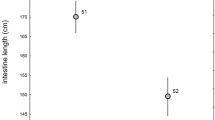Abstract
Teleost fish are frequently in danger of being preyed upon. Predators of many taxa are specialised piscivores and there are more of them that attack small fish. Therefore, young fish normally live under a high risk of predation, which decreases as they grow older and bigger. Growing fast is not only a good strategy for esca** the prey spectrum of many predators, but also for increasing reproductive success; bigger teleosts are generally able to produce more numerous offspring than smaller ones because bigger females produce more eggs, and bigger males can defend breeding sites better and have a higher social rank; for example, dominant male threespined sticklebacks (Gasterosteus aculeatus) maintain larger territories and have priority of access to females (Li and Owings 1978). Thus, there is a high selection pressure to feed most efficiently in order to grow quickly.
Access this chapter
Tax calculation will be finalised at checkout
Purchases are for personal use only
Preview
Unable to display preview. Download preview PDF.
Similar content being viewed by others
References
Arme, C. and Owen, R.W. (1967) `Infections of the Three-spined Stickleback, Gasterosteus aculeatus L., with the Plerocercoid larvae of Schistocephalus solidus (Willer 1776), with Special Reference to Pathological Effects’, Parasitology, 57, 301–14
Cerri, R.D. and Fraser, D.F. (1983) `Predation and Risk in Foraging Minnows: Balancing Conflicting Demands’, American Naturalist, 121, 552–61
Crowden, A.E. and Broom, D.M. (1980) `Effects of the Eyefluke, Diplostomum spathaceum, on the Behaviour of Dace (Leuciscus leuciscus)’, Animal Behaviour, 28, 287–94
Dill, L.M. (1983) `Adaptive Flexibility in the Foraging Behaviour of Fishes’, Canadian Journal of Fishery and Aquatic Sciences, 40, 398–408
Dill, L.M. and Fraser, A.H.G. (1984) `Risk of Predation and the Feeding Behaviour of Juvenile Coho Salmon (Oncorhynchus kisutch)’, Behavioural Ecology and Sociobiology, 16,65–72
Giles, N. (1983) `Behavioural Effects of the Parasite Schistocephalus solidus (Cestoda) on an Intermediate Host, the Three-spined Stickleback, Gasterosteus aculeatus L’, Animal Behaviour, 31, 1192–4
Gilliam, J.F. (1982) `Habitat Use and Competitive Bottlenecks in Size-structured FishPopulations’, unpublished PhD dissertation, Michigan State University, East Lansing Heller, R. and Milinski, M. (1979) `Optimal Foraging of Sticklebacks on Swarming Prey’,Animal Behaviour, 27, 1127–41
Janetos, A.C. and Cole, B.J. (1981) `Imperfectly Optimal Animals’, Behavioural Ecology and Sociobiology, 9, 203–9
Janssen, J. (1976) `Feeding Modes and Prey Size Selection in the Alewife (Alosa pseudoharengus)’, Journal of the Fisheries Research Board of Canada, 33, 1972–5
Kniprath, E. (1965) ‘Stichlinge als Nahrung des Eisvogels and des Teichhuhns’, Ornithologischer Beobachter, 62, 190–2
Krebs, J.R. (1980) `Optimal Foraging, Predation Risk and Territory Defence’, Ardea, 68, 83–90
Krebs, J.R., Stephens, D.W. and Sutherland, W.J. (1983) `Perspectives in Optimal Foraging’, Perspectives in Ornithology, Essays Presented for the Centennial of the American Ornithologists’ Union, Cambridge University Press, Cambridge, pp. 165–221
Lazarus, J. (1979) `The Early Warning Function of Flocking in Birds: an Experimental Study with Captive Quelea’, Animal Behaviour, 27, 855–65
Lester, R.J.G. (1971) `The Influence of Schistocephalus Plerocercoids on the Respiration of Gasterosteus and a Possible Resulting Effect on the Behavior of the Fish’, Canadian Journal of Zoology, 49, 361–6
Li, S.K. and Owings, D.H. (1978) `Sexual Selection in the Three-spined Stickleback. I. Normative Observations’, Zeitschrift für Tierpsychologie, 46, 359–71
McCleery, R.H. (1978) `Optimal Behaviour Sequences and Decision Making’, in J.R. Krebs and N.B. Davies (eds), Behavioural Ecology: an Evolutionary Approach, Blackwell, Oxford, pp. 337–410
McNaught, D.C. and Hasler, A.D. (1961) `Surface Schooling and Feeding Behavior in the White Bass, Roccus chrysops (Rafinesque), in Lake Mendota’, Limnology and Oceanography, 6, 53–60
Magurran, A.E., Ou1ton, W.J. and Pitcher, T.J. (1985) `Vigilant Behaviour and Shoal Size in Minnows’, Zeitschrift für Tierpsychologie, 67, 167–78
Milinski, M. (1977a) `Experiments on the Selection by Predators against Spatial Oddity of their Prey’, Zeitschrift für Tierpsychologie, 43, 311–25
Milinski, M. (1977b) `Do All Members of a Swarm Suffer the Same Predation?’, Zeitschrift für Tierpsychologie, 45, 373–88
Milinski, M. (1984a) `A Predator’s Costs of Overcoming the Confusion Effect of Swarming Prey’, Animal Behaviour, 32, 1157–62
Milinski, M. (1984b) `Parasites Determine a Predator’s Optimal Feeding Strategy’, Behavioural Ecology and Sociobiology, 15, 35–7
Milinski, M. (1985) `Risk of Predation Taken by Parasitised Sticklebacks under Competition for Food’, Behaviour, 93, 203–16
Milinski, M. and Heller, R. (1978) `Influence of a Predator on the Optimal Foraging Behaviour of Sticklebacks (Gasterosteus aculeatus L.)’, Nature, London, 275, 642–4
Ohguchi, O. (1981) `Prey Density and Selection against Oddity by Three-spined Sticklebacks’, Supplement No. 23 to Zeitschrift für Tierpsychologie
Powell, G.V.N. (1974) `Experimental Analysis of the Social Value of Flocking by Starlings (Sturnus vulgaris) in Relation to Predation and Foraging’, Animal Behaviour, 22, 501–5
Power, M.E. (1984) `Depth Distributions of Armored Catfish: Predator-induced Resource Avoidance’, Ecology, 65, 523–8
Dobben, W.H. (1952) `The Food of the Cormorants in The Netherlands’, Ardea, 40, 1–63
Werner, E.E., Gilliam, J.F., Hall, D.J., and Mittelbach, G.G. (1983) ‘An Experimental Test of the Effects of Predation Risk on Habitat Use in Fish’, Ecology, 64, 1540–8
Wootton, R.J. (1976) The Biology of the Sticklebacks, Academic Press, London
Editor information
Editors and Affiliations
Rights and permissions
Copyright information
© 1986 Tony J. Pitcher
About this chapter
Cite this chapter
Milinski, M. (1986). Constraints Placed by Predators on Feeding Behaviour. In: Pitcher, T.J. (eds) The Behaviour of Teleost Fishes. Springer, Boston, MA. https://doi.org/10.1007/978-1-4684-8261-4_9
Download citation
DOI: https://doi.org/10.1007/978-1-4684-8261-4_9
Publisher Name: Springer, Boston, MA
Print ISBN: 978-1-4684-8263-8
Online ISBN: 978-1-4684-8261-4
eBook Packages: Springer Book Archive




